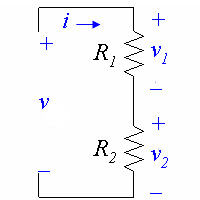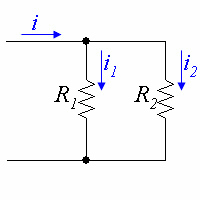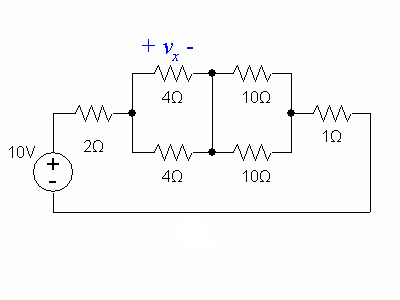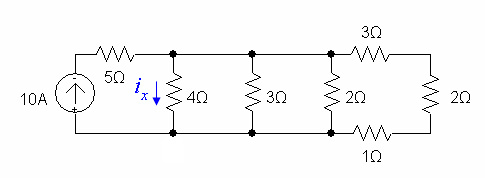Difference between revisions of "Voltage and Current Dividers"
| (10 intermediate revisions by 3 users not shown) | |||
| Line 1: | Line 1: | ||
__TOC__ |
__TOC__ |
||
==Voltage Division== |
==Voltage Division== |
||
When we have a voltage across a string of resistors connected in series, |
When we have a voltage across a string of resistors connected in series, the voltage across the entire string will be divided up among the resistors. We can express the voltage across a single resistor as a ratio of voltages and resistances, without ever knowing the current. |
||
[[Image:voltage_division1. |
[[Image:voltage_division1.gif]] |
||
In the circuit above, |
In the circuit above, |
||
| Line 13: | Line 13: | ||
<math>v_1=\frac{R_1}{R_1+R_2}v</math> |
<math>v_1=\frac{R_1}{R_1+R_2}v</math> |
||
We can generalize this equation for <math>N</math> |
We can generalize this equation for <math>N</math> resistors in series with the equation: |
||
<math>v_k=\frac{R_k}{R_1+R_2+\cdot\cdot\cdot+R_N}v</math> |
<math>v_k=\frac{R_k}{R_1+R_2+\cdot\cdot\cdot+R_N}v</math> |
||
where <math>v_k</math> is the voltage across resistor < |
where <math>v_k</math> is the voltage across resistor <math>k</math> and <math>v</math> is the voltage across the whole string of resistors. |
||
==Current Division== |
==Current Division== |
||
When we have a current flowing through resistors in parallel, we can express the current flowing through a single resistor as ratio of currents and resistances, without ever knowing the voltage. |
Resistors in parallel divide up the current. When we have a current flowing through resistors in parallel, we can express the current flowing through a single resistor as ratio of currents and resistances, without ever knowing the voltage. |
||
[[Image:current_division1. |
[[Image:current_division1.gif]] |
||
In the circuit above |
In the circuit above |
||
<math>\frac{i_1}{i}= |
<math>\frac{i_1}{i}=\frac{R_2}{R_1+R_2}</math> |
||
or |
or |
||
| Line 34: | Line 34: | ||
where <math>i</math> is the current flowing through all the resistors. '''Note that the numerator on the right is R2, not R1.''' Remember that a larger resistance will carry a smaller current. |
where <math>i</math> is the current flowing through all the resistors. '''Note that the numerator on the right is R2, not R1.''' Remember that a larger resistance will carry a smaller current. |
||
We can generalize the equation for <math>N</math> |
We can generalize the equation for <math>N</math> resistors in parallel with the equation: |
||
<math>i_k=\frac{\frac{1}{R_k}}{\frac{1}{R_1}+\frac{1}{R_2}+\cdot\cdot\cdot+\frac{1}{R_N}}i</math> |
<math>i_k=\frac{\frac{1}{R_k}}{\frac{1}{R_1}+\frac{1}{R_2}+\cdot\cdot\cdot+\frac{1}{R_N}}i</math> |
||
| Line 44: | Line 44: | ||
Use voltage division to find <math>v_x</math> in the circuit below: |
Use voltage division to find <math>v_x</math> in the circuit below: |
||
[[Image:voltage_division_problem1. |
[[Image:voltage_division_problem1.gif]] |
||
[[Answer to voltage division problem 1|click here for the solution]] |
[[Answer to voltage division problem 1|click here for the solution]] |
||
| Line 51: | Line 51: | ||
Simplify the circuit and then use current division to find <math>i_x</math> in the circuit below: |
Simplify the circuit and then use current division to find <math>i_x</math> in the circuit below: |
||
[[Image:current_division_problem1. |
[[Image:current_division_problem1.gif]] |
||
[[Answer to currentdivision problem 1|click here for the solution]] |
[[Answer to currentdivision problem 1|click here for the solution]] |
||
Latest revision as of 00:33, 14 January 2010
Voltage Division
When we have a voltage across a string of resistors connected in series, the voltage across the entire string will be divided up among the resistors. We can express the voltage across a single resistor as a ratio of voltages and resistances, without ever knowing the current.
In the circuit above,
or
We can generalize this equation for resistors in series with the equation:
where is the voltage across resistor and is the voltage across the whole string of resistors.
Current Division
Resistors in parallel divide up the current. When we have a current flowing through resistors in parallel, we can express the current flowing through a single resistor as ratio of currents and resistances, without ever knowing the voltage.
In the circuit above
or
where is the current flowing through all the resistors. Note that the numerator on the right is R2, not R1. Remember that a larger resistance will carry a smaller current.
We can generalize the equation for resistors in parallel with the equation:
where is the current flowing through resistor and is the current flowing through all the resistors.
Practice Problems
Problem 1
Use voltage division to find in the circuit below:
Problem 2
Simplify the circuit and then use current division to find in the circuit below:

















